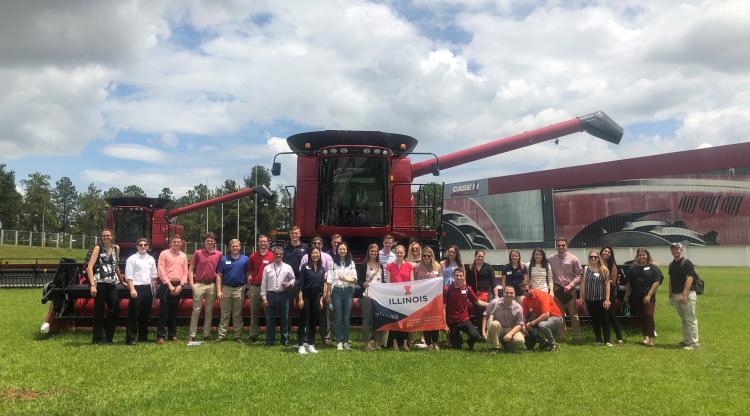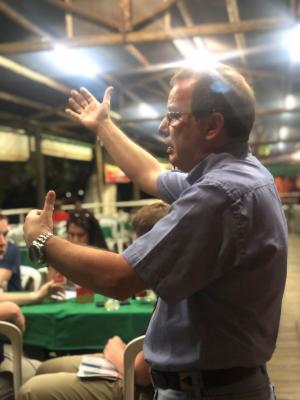Combines, College, & Cane

On the fifth day of our journey in Brazil, we started off at CNH Industrial in Sorocaba, followed by three lectures at ESALQ (University of Sao Paulo) and ended at a dinner with the ALPA director in Piracicaba. At CNH we met with Miguel and Roberto, our lecturers were: Professor Heliane, Professor Jose and Professor Silvia, and at dinner we met with Flavio.
At CNH we learned about the company from Roberto Biasotto, the product marketing manager for sugarcane and coffee harvesters. He described to us the presence of CNH in Latin America. 11.5% of the company’s revenues come from Latin America, vs 21.8% from North America. In Latin America, CNH has factories that produce combine harvesters, sugarcane and coffee harvesters, tractors, engine components, sprayers, and planters. The factory we visited produces combine harvesters, from midrange to flagship models. Miguel explained it was mostly shut down due to the new years holiday, but some presses and laser cutting machines were in use. They produce roughly ten combines a day, which results in over 2,000 per year.
In our first lecture we heard from Professor Helaine Correr of ESALQ. Her presentation gave us a better understanding of our sister agricultural college. ESALQ is known as the Luiz de Queiroz College of Agriculture. This comes from the name of the founder, Luiz de Queiroz, who donated his farm land in Piracicaba to the state of Sao Paulo in 1901. ESALQ consists of about 3,000 undergrad and grad students. Here their students participate in different agriculture fields much like in our college of ACES. One unique program we learned about was their “Double Degree Program”. This program allows for students to not only get a degree from ESALQ, but they are also able to earn a degree from an international institution (like Agro Paris Tech, Ohio State University, etc.). Overall, it was great to learn more about our sister college and we look forward to completing the campus tour tomorrow.
José Caixeta discussed the logistical challenges faced within Brazil. There currently is little to no on-farm storage within the country so all of the commodities must be shipped immediately. This occurs through the use of highway freight as there is extremely limited access to rail. Farmers that do sell to rail pay the shipping costs associated with trucking the bushels to port. Rail transportation also takes far longer than trucking. One of the primary focuses is to have farmers backhaul fertilizer from the port during harvest. The problem is that storage for fertilizer is required because it is applied after harvest. Farmers in the middle of Brazil are starting to adapt the grain elevator model currently found throughout the United States. The infrastructure within Brazil is extremely lacking because regulations did not exist until the early 2000s making railways incompatible and some roads in disrepair. José commented that some simple problems still need to be solved. The future of Brazil is bright as long as logistical models are utilized when making decisions moving forward.
Professor Silvia Miranda who focuses on the Center of Advanced Studies and Applied Economics. Silvia explained that CEPEA centers on providing efficient and sustainable management for agricultural businesses. As part of her research group, where she started 25 years ago, she studied the cost of production and various economic indicators. Her group partners with various businesses including farmers, processors, financial institutions, the input industry, and distribution and wholesale levels to gather information regarding trade and prices. Additionally, she touched on how climate change has been a factor in beef and its prices. Alongside with climate issues, she highlighted the forest code. Although the government has placed various laws and policies to help conserve the rainforest, it is difficult to reinforce due to the issues in information (identifying a farmer's actual land). She explained that the government has incentivized farmers by giving credit lines to those that adhere to the forest code and lowering interest rates to those that plant more trees in their land. However, with the difficulty to obtain the incentives the government offers, farmers turn to private companies for credit lines. All in all, Silvia gave a great insight on what CEPEA offers and the projects that she has ahead.
Flavio is an extremely talented businessman that works at a sugarcane ethanol company where he started 11 years ago. After starting APLA the government had asked him to run APLA and be in charge. At the moment they are in charge of roughly 10 million hectares of sugarcane throughout 9 processing plants. Flavio was going into detail on how all the sugarcane must be within 30 miles of the plant or else the plant will go bad before processing. They came out with the first crop of GMO sugarcane where the crop is the exact same as non GMO sugar cane but doesn’t allow fly larvae to enter the crop due to the larvae not enjoying the taste of the sugar. Sugarcane is one of the highest paying crops out of corn, soybeans, and coffee. In a greenhouse ALPA was able to grow 300 tons per hectare but in a controlled area. Another important fact about sugarcane is that you can’t store the crop. ALPA was able to find that CO2 emission is actually lower in sugarcane over corn. What is interesting about ALPA is that it is a non for profit organization that is government backed and funded by research parks. We then talked about Flavio’s time traveling throughout the world for his work as well as his time spent in the US backpacking throughout the states. We enjoyed this conversation all while having delicious food at Chevette which is a restaurant on the river.

